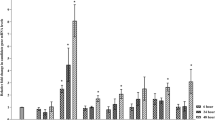Abstract
A synthetic scorpion Hector Insect Toxin (AaHIT) gene, under the control of a CaMV35S promoter, was cloned into cotton via Agrobacterium tumefaciens-mediated transformation. Southern blot analyses indicated that integration of the transgene varied from one to more than three estimated copies per genome; seven homozygous transgenic lines with one copy of the T-DNA insert were then selected by PCR and Southern blot analysis. AaHIT expression was from 0.02 to 0.43% of total soluble protein determined by western blot. These homozygous transgenic lines killed larvae of cotton bollworm (Heliothis armigera) by 44–98%. The AaHIT gene could used therefore an alternative to Bt toxin and proteinase inhibitor genes for producing transgenic cotton crops with effective control of bollworm.





Similar content being viewed by others
References
An G (1987) Binary Ti vectors for plant transformation and promoter analysis. Meth Enzymol 153:292–305
Benedict JH, Altman DW (2001) Commercialization of transgenic cotton expressing insecticidal crystal protein. In: Jenkins JN, Saha S (eds) Genetic improvement of cotton; emerging technologies. Science Publishers, UK, pp 137–201
Cestele S, Catterall WA (2000) Molecular mechanisms of neurotoxin action on voltage-gated sodium channels. Biochimie 82:883–892
Darbon H, Zoltkin E, Kopeyan C et al (1982) Covalent structure of the insect toxin of the North African scorpion Androctonus australis Hector. Int J Pept Prot Res 20:320–330
DeLeo F, Bonade-Bottino MA, Ceci LR et al (1998) Opposite effects on Spodoptera littoralis larvae of high expression level of a trypsin proteinase inhibitor in transgenic plants. Plant Physiol 118:997–1004
Guo HN, Wu JH, Chen XY et al (2003) Cotton plants transformed with the activated chimeric CrylAc and API-B genes. Acta Bot Sin 45:108–113
Ibargutxi M, Estela A, Ferre J et al (2006) Use of Bacillus thuringiensis Toxins for Control of the Cotton Pest Earias insulana (Boisd.) (Lepidoptera: Noctuidae). Appl Environ Microbiol 72:437–442
Ishimoto M, Chrispeels MJ (1996) Protective mechanism of the Mexican bean weevil against high levels of α-amylase inhibitor in the common bean. Plant Physiol 111:393–401
Kurland CG (1991) Codon bias and gene expression. FEBS Lett 22:165–169
Moskowitz HR, Herrmann AD, Hammock BD (1998) A depressant insect-selective toxin analog from the venom of the scorpion Leiurus quinquestriatus hebraeus, purification and structure/function characterization. Eur J Biochem 254:44–49
Murashige T, Skoog FA (1962) Revised medium for rapid growth and bioassays with tobacco tissue cultures. Physiol Plant 15:473–479
Murray EE, Lotzer J Eberle M (1989) Codon usage in plant genes. Nucleic Acid Res 17:477–498
Paterson AH, Brubaker CL, Wendel JF (1993) A rapid method for extraction of cotton (Gossypium ssp.) genomic DNA suitable for RFLP or PCR analysis. Plant Mol Biol Rep 11:122–127
Perlak FJ, Fuchs RL, Dean DA et al (1991) Modification of the coding sequence enhances plant expression of insect control protein genes. Proc Natl Acad Sci USA 88:3324–3328
Perlak FJ, Oppenhuizen M, Gustafson K et al (2001) Development and commercial use of Bollgard cotton in the USA—early promises versus today’s reality. Plant J 27:489–501
Morton RL, Schroeder HE, Bateman KS (2000) Bean α-amylase inhibitor 1 in transgenic peas (Pisum sativum) provides complete protection from pea weevil (Bruchus pisorum) under field conditions. Proc Natl Acad Sci USA 97:3820–3825
Sambrook J, Russell DW (2001) Molecular cloning: a laboratory manual, 3rd edn. Cold Spring Harbor Laboratory Press, New York
Smith RH, Smith JW, Park SH (2004) Cotton transformation: successes and challenges. In: Liang GH, Skinner DZ (eds) Genetically modified crops, their development, uses and risks. Food Product Press, an Imprint of the Haworth Press. Inc., New York, London, Oxford, pp 247–252
Sun JC, Tang M, Zhu XF (2002) Characterization of resistance to Helicoverpa armigera in three lines of transgenic Bt Upland cotton. Euphytica 123:343–351
Umbeck PG, Barton JK, Swain W (1987) Genetically transformed cotton (Gossypium hirsutum L.) plants. Biotech 5:263–267
Zhao JZ, Cao J, Collins HL (2005) Concurrent use of transgenic plants expressing a single and two Bacillus thuringiensis genes speeds insect adaptation to pyramided plants. Proc Natl Acad Sci USA 102:8426–8430
Zlotkin E, Miranda F, Kopeyan C (1971) A new toxic protein in the venom of the scorpion Androctonus australis Hector. Toxicon 9:9–13
Acknowledgements
This study was supported by the grants from the Nature Science Foundation of China (39970416), and the Science and Technology Department of Shanxi Province (041001-1).
Author information
Authors and Affiliations
Corresponding author
Rights and permissions
About this article
Cite this article
Wu, J., Luo, X., Wang, Z. et al. Transgenic cotton expressing synthesized scorpion insect toxin AaHIT gene confers enhanced resistance to cotton bollworm (Heliothis armigera) larvae. Biotechnol Lett 30, 547–554 (2008). https://doi.org/10.1007/s10529-007-9555-7
Received:
Revised:
Accepted:
Published:
Issue Date:
DOI: https://doi.org/10.1007/s10529-007-9555-7




